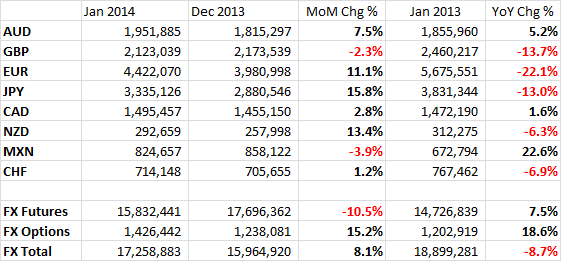CME January FX Volumes Up on Japanese Yen and Options Growth
- Total monthly FX volumes at the CME rose during January compared to December’s data. For the month, total futures and options contracts traded were 17,258,883, up 8.1% from December’s trading.

Total monthly FX volumes at the CME rose during January compared to December’s data. For the month, total futures and options contracts traded were 17,258,883, up 8.1% from December’s trading, but 8.7% below the same period in 2013. For the month, average daily volumes (ADV) were 821,852 contracts. The month over month growth was part of an overall solid month for the CME where all its product divisions saw gains, with ADVs up 18.3% from December to 12.9 million contracts. Specifically, interest rate product activity grew over 25% from December.
In terms of individual FX products, the euro saw the most activity at a total of 4.42 million contracts traded, trailing by the yen at 3.34 million. The yen’s 15.8% month over month growth led all major currencies. Also continuing to show positive growth were FX options, which notched both month over month and yearly growth as 1,43 million contracts were traded in January (see below). FX options performed well throughout 2013 for the CME as they provided a leveraged method to speculate on Volatility Volatility In finance, volatility refers to the amount of change in the rate of a financial instrument, such as commodities, currencies, stocks, over a given time period. Essentially, volatility describes the nature of an instrument’s fluctuation; a highly volatile security equates to large fluctuations in price, and a low volatile security equates to timid fluctuations in price. Volatility is an important statistical indicator used by financial traders to assist them in developing trading systems. Traders In finance, volatility refers to the amount of change in the rate of a financial instrument, such as commodities, currencies, stocks, over a given time period. Essentially, volatility describes the nature of an instrument’s fluctuation; a highly volatile security equates to large fluctuations in price, and a low volatile security equates to timid fluctuations in price. Volatility is an important statistical indicator used by financial traders to assist them in developing trading systems. Traders Read this Term levels as well as earn returns during slow markets.

CME January 2014 FX Contract Volumes
Total monthly FX volumes at the CME rose during January compared to December’s data. For the month, total futures and options contracts traded were 17,258,883, up 8.1% from December’s trading, but 8.7% below the same period in 2013. For the month, average daily volumes (ADV) were 821,852 contracts. The month over month growth was part of an overall solid month for the CME where all its product divisions saw gains, with ADVs up 18.3% from December to 12.9 million contracts. Specifically, interest rate product activity grew over 25% from December.
In terms of individual FX products, the euro saw the most activity at a total of 4.42 million contracts traded, trailing by the yen at 3.34 million. The yen’s 15.8% month over month growth led all major currencies. Also continuing to show positive growth were FX options, which notched both month over month and yearly growth as 1,43 million contracts were traded in January (see below). FX options performed well throughout 2013 for the CME as they provided a leveraged method to speculate on Volatility Volatility In finance, volatility refers to the amount of change in the rate of a financial instrument, such as commodities, currencies, stocks, over a given time period. Essentially, volatility describes the nature of an instrument’s fluctuation; a highly volatile security equates to large fluctuations in price, and a low volatile security equates to timid fluctuations in price. Volatility is an important statistical indicator used by financial traders to assist them in developing trading systems. Traders In finance, volatility refers to the amount of change in the rate of a financial instrument, such as commodities, currencies, stocks, over a given time period. Essentially, volatility describes the nature of an instrument’s fluctuation; a highly volatile security equates to large fluctuations in price, and a low volatile security equates to timid fluctuations in price. Volatility is an important statistical indicator used by financial traders to assist them in developing trading systems. Traders Read this Term levels as well as earn returns during slow markets.

CME January 2014 FX Contract Volumes
